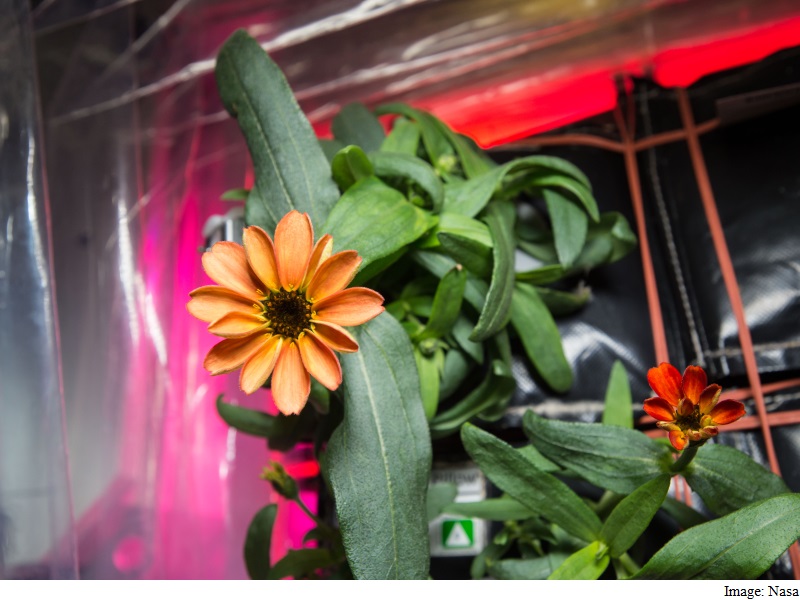- Home
- Science
- Science News
- Space Gardening Can Help Astronauts Reduce Stress, Says Nasa
Space Gardening Can Help Astronauts Reduce Stress, Says Nasa

In space, there is no scent of baking bread, no wind in your face, no sound of raindrops hitting the roof, no favourite kitten to curl up in your lap. Over time, being deprived of these common earthbound sense stimulations takes a toll.
Having limited access to stimuli to the senses has been identified as a significant risk by the health performance team.
Gardening provides recreation and relaxation, the Nasa team said in a statement.
Nasa astronaut Kjell Lindgren activated the growth of zinnia plants on November 16, 2015, as part of an experiment in the space agency's Vegetable Production System (VEGGIE), a facility that will help scientists learn how to grow fresh produce on orbit for the agency's journey to Mars.
Lindgren's work with the zinnias was continued by Kelly after Lindgren's departure. They are using red, green and blue LED lights 10 hours a day to stimulate growth of the plants.
The zinnias bloomed, Commander Scott Kelly announced with a tweet. "Yes, there are other life forms in space!" he tweeted on January 16.
Working with plants could provide astronauts visual, tactile and olfactory stimulation, and eventually even salivary stimulation with fresh foods and variety, the Nasa statement said.
Another space gardener, Nasa astronaut Don Pettit, conducted his own personal experiments with growing plants in space during Expedition 30/31.
"I grew three plants on my last mission," Pettit said. "Space zucchini, and then he had his buddy space broccoli. And then there was space sunflower," Pettit noted.
To enhance his fun, he even wrote a blog from the point of view of space zucchini.
Experiments involving space plants have been a favourite of astronauts, especially those staying in space for long periods of time.
"Growing a flowering crop is more challenging than growing a vegetative crop such as lettuce," said Gioia Massa, Nasa Kennedy Space Center scientist for VEGGIE.
"Lighting and other environmental parameters are more critical," Massa noted.
Lessons learned from the zinnia study will be used to help with the next flowering plant experiment in 2017, this one with an edible outcome - tomatoes - the statement -added.
For the latest tech news and reviews, follow Gadgets 360 on X, Facebook, WhatsApp, Threads and Google News. For the latest videos on gadgets and tech, subscribe to our YouTube channel. If you want to know everything about top influencers, follow our in-house Who'sThat360 on Instagram and YouTube.
Related Stories
- Samsung Galaxy Unpacked 2025
- ChatGPT
- Redmi Note 14 Pro+
- iPhone 16
- Apple Vision Pro
- Oneplus 12
- OnePlus Nord CE 3 Lite 5G
- iPhone 13
- Xiaomi 14 Pro
- Oppo Find N3
- Tecno Spark Go (2023)
- Realme V30
- Best Phones Under 25000
- Samsung Galaxy S24 Series
- Cryptocurrency
- iQoo 12
- Samsung Galaxy S24 Ultra
- Giottus
- Samsung Galaxy Z Flip 5
- Apple 'Scary Fast'
- Housefull 5
- GoPro Hero 12 Black Review
- Invincible Season 2
- JioGlass
- HD Ready TV
- Laptop Under 50000
- Smartwatch Under 10000
- Latest Mobile Phones
- Compare Phones
- Moto G15 Power
- Moto G15
- Realme 14x 5G
- Poco M7 Pro 5G
- Poco C75 5G
- Vivo Y300 (China)
- HMD Arc
- Lava Blaze Duo 5G
- Asus Zenbook S 14
- MacBook Pro 16-inch (M4 Max, 2024)
- Honor Pad V9
- Tecno Megapad 11
- Redmi Watch 5
- Huawei Watch Ultimate Design
- Sony 65 Inches Ultra HD (4K) LED Smart TV (KD-65X74L)
- TCL 55 Inches Ultra HD (4K) LED Smart TV (55C61B)
- Sony PlayStation 5 Pro
- Sony PlayStation 5 Slim Digital Edition
- Blue Star 1.5 Ton 3 Star Inverter Split AC (IC318DNUHC)
- Blue Star 1.5 Ton 3 Star Inverter Split AC (IA318VKU)

















